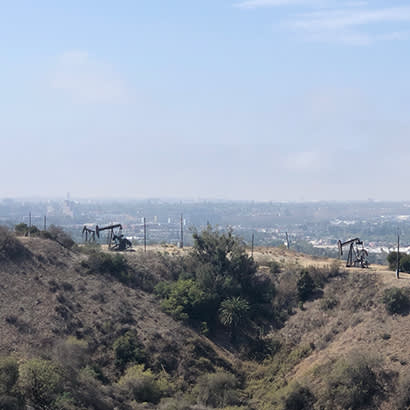
Pictured: Three pumpjacks (“nodding donkey” oil rigs) at Inglewood Oil Field, as seen from Baldwin Hills Scenic Overlook. Photo by Jengod.
In the era of climate change and environmental degradation, the concept of a "just transition" has gained prominence. This term refers to the shift from an economy reliant on fossil fuels to one centered around renewable energy and sustainable practices, while ensuring that the process is equitable and inclusive. One notable example of just transition in action is the transformation of oil fields into parks and open space where and when appropriate as determined through a stakeholder engagement process. This endeavor not only addresses environmental concerns but also promotes social justice, economic revitalization, and community well-being.
Environmental Restoration and Regeneration
The most immediate and visible benefit of converting oil fields into parks and open space is the restoration and regeneration of degraded lands. Oil extraction leaves a significant ecological footprint, characterized by contaminated soil, polluted water, and disrupted ecosystems. By transforming these areas into parks, we initiate a process of land restoration and regeneration. Soil remediation, reforestation, and the creation of green spaces help to mitigate the environmental damage caused by years of oil extraction. These parks and open space can become havens for local wildlife, support biodiversity, and contribute to carbon sequestration, playing a crucial role in mitigating climate change.
Economic Opportunities and Job Creation
A just transition must address the economic impacts on workers and communities dependent on the fossil fuel industry. The transformation of oil fields into parks can create new economic opportunities and jobs in various sectors, including environmental remediation, landscaping, construction, and park management. Workers previously employed in the oil industry can be retrained and redeployed in these new roles, ensuring they are not left behind in the transition to a green economy. Furthermore, parks can attract tourism, boosting local economies and generating additional revenue streams for communities.
Community Health and Well-Being
Oil fields, especially those located near residential areas, pose significant health risks due to air and water pollution. Converting these sites into parks and open space can drastically improve community health and well-being. Green spaces are known to offer multiple benefits, including reducing stress, improving mental health, and encouraging physical activity. They provide safe, accessible areas for recreation and respite for families and children, fostering a sense of community and belonging. Additionally, the reduction in pollution from decommissioned oil fields leads to cleaner air and water, directly benefiting public health.
Social Equity and Inclusivity
A key principle of just transition is social equity, ensuring that the benefits of the green economy are shared by all, particularly marginalized communities. Historically, many oil fields have been located in low-income areas and communities of color, disproportionately exposing them to environmental burdens and hazards. Transforming these sites into parks and open space is an act of environmental justice, addressing historical inequities and providing these communities with much-needed green spaces. It ensures that the benefits of a cleaner environment and improved quality of life are accessible to everyone, not just the affluent.
Cultural Preservation and Revitalization
Many oil fields and other industrial sites are located on or near lands that were traditionally inhabited and/or cared for by Native Nations. Transforming oil fields into parks provides an opportunity to preserve and revitalize Indigenous cultures, with parks serving as spaces for ceremonies, cultural education and practices, and community gatherings. They may include interpretive centers and programs that highlight the history, traditions, and contributions of Native Nations. This not only educates the broader public but also strengthens cultural identity and pride within Indigenous communities. Ensuring that these spaces reflect Indigenous heritage and values is a crucial aspect of social equity.
Policy and Governance
Successful transformation of oil fields into parks requires robust policy frameworks and governance structures. Governments at all levels must prioritize funding and regulatory support for these impactful projects. Collaboration between public agencies, private sector stakeholders, and community-based organizations is essential to ensure the projects are effectively planned and implemented. Policies should also include provisions for long-term operation and maintenance of these parks to ensure their sustainability and continued benefits.
Conclusion
The transformation of oil fields into parks embodies the principles of just transition, offering a multifaceted approach to addressing environmental, economic, social, and historical challenges. It is a powerful example of how we can move towards a sustainable future, ensuring that the transition away from fossil fuels benefits all members of society. By investing in these initiatives, we not only heal the land and scars of the past but also lay the foundation for a greener, healthier, and more just world.
Clement Lau, DPPD, FAICP, is a Senior Analyst with the Los Angeles County Chief Sustainability Office. He was previously a Departmental Facilities Planner with the County’s Department of Parks and Recreation.


